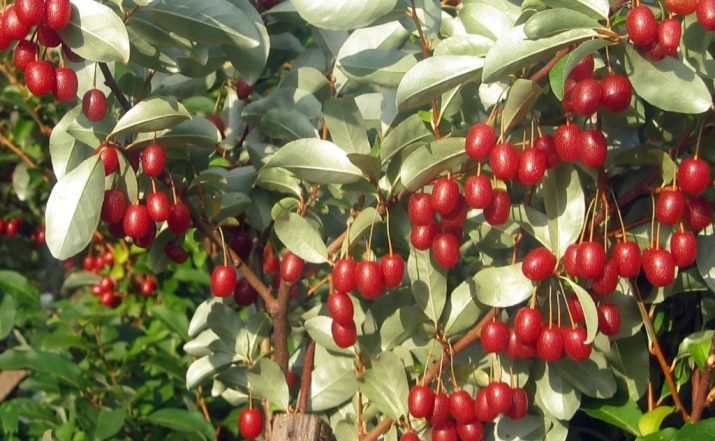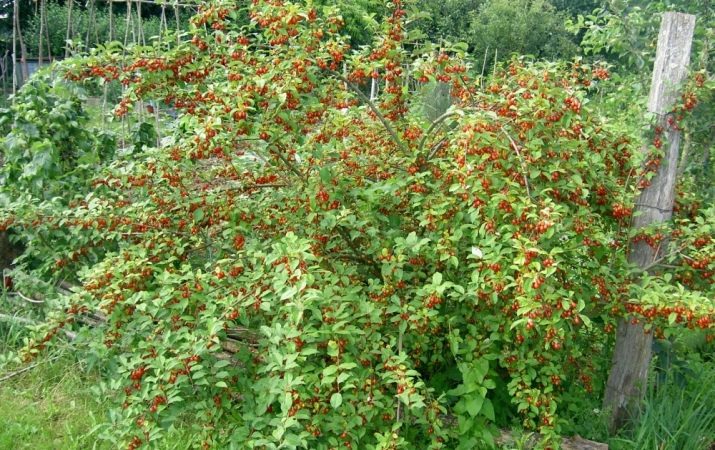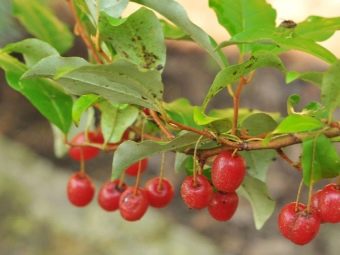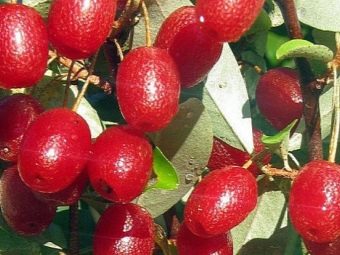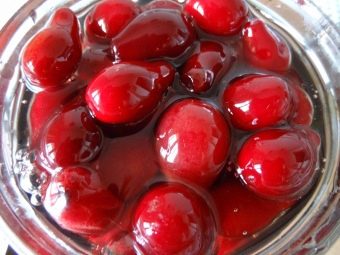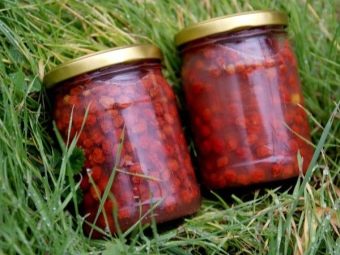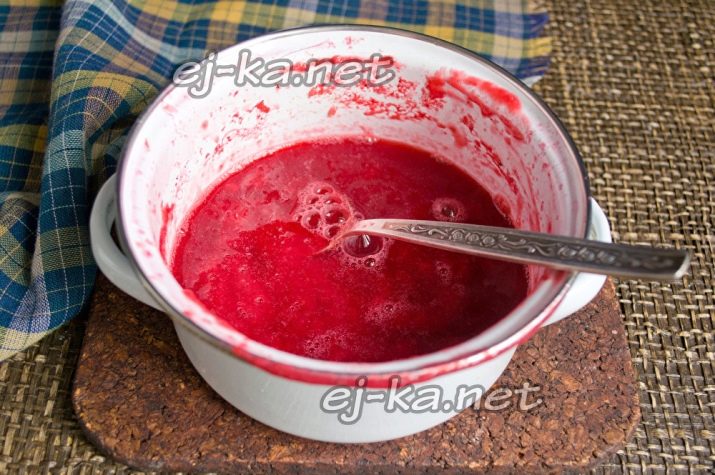Gumi: properties, recipes and cultivation guidelines
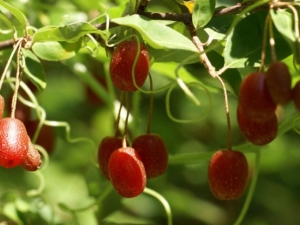
The plant called gumi is not widely known in our country. It is quite popular in the cities of Japan, Korea, and China.The berry shrub is also called the multi-flowered sucker, it is unique in its characteristics, a favorable effect on a person and has an attractive appearance.
Description
Gumi belongs to the family of Lokhovs, it is considered a botanical relative of the sea buckthorn. The bush has the appearance of a strong-growing, branchy shrub with flexible, spiky shoots. The height of the sucker of many flowers can be from one and a half to three meters. During flowering, it looks attractive due to its numerous and pleasantly smelling flowers. The flowering period at the bush is the second half of May. After one and a half months from the moment of pollination, fruit ripening begins.
The leaves of this medicinal plant have a leathery structure and an elliptical shape, their surface is shiny and smooth. The root system has nodules in which bacteria settle, which fix nitrogen. For the first time, the Loss of many flowers bears fruit by the third year since planting. Fruit ripening occurs in the middle of the summer period.
Biologically ripe berries have a skin of red color, they are small in size and oval in shape. Fruits have the opportunity to be on the branches, without crumbling, until the frosty period. Berries are characterized by transparency and juicy pulp, as well as sweet-sour taste, in which there is astringency.
Fruit ripening does not occur at the same time. Gumi is a fruitful representative of its family, as it allows you to collect about 10 kilograms of crop from one plant. The use of gumi fruit is universal. They are quite tasty when just picked, as well as in dried form, in jam, jam, compote and even meat sauce. If you keep the fruits of the sucker many-flowered for a long time, they become dried, if you freeze them, the shelf life of the fruit increases to eight months.
Landing gumi on your site will provide several functions at once:
- decorative;
- honey;
- economic.
In areas with a mild warm climate, this plant is evergreen, so it looks attractive throughout the year.
Benefit
Useful properties of gumi are provided by its unique composition. The culture is rich in amino acids, sugar, carotene, tanning and pectin elements, phosphoric, potassium, calcium salt. Due to the presence of such elements, the plant is often used in recipes of traditional medicine for healing. The amount of vitamin C in the berries of the sucker of this species is much higher than in black currants and citrus.
The fruits of gumi are able to have a fortifying, anti-inflammatory, tonic effect on the human body. They are used to prevent sclerosis, improve blood circulation, improve the functioning of the stomach and the functioning of the heart and blood vessels.
The benefits of gum berries are appreciated by caring parents who use the plant as a vitamin and natural supplement in the diet to their children.
Harm
A multi-flowered sucker can be harmful only when a person has an individual intolerance to this product. Diabetics should exercise caution when consuming the fruits of gumi. No other contraindications have been established.
Sorta
Since 1999, the State Register of Breeding Achievements has recorded a varietal variety of sucker multicolor. Today the most famous varieties of gum can be called the following.
- "Sakhalin first". The variety belongs to the early ripening. Its fruits are characterized by an ovoid shape, red skin and a weight of about 1.5 grams. The fruits of the Sakhalin First are rather pleasant to the taste, they are refreshing and have a slight sourness. The bush is resistant to infectious lesions and practically does not suffer from attacks of parasites.
- "Moneron". This variety is valued for its high frost resistance and stable yields. Fruits contain a large amount of sugars, but are often affected by diseases and pests.
- "Taisa" It is considered an early ripe dessert variety.The plant is convenient in the care and preparation for the winter due to the presence of thorns only on adult shoot. "Taisa" has a high resistance to freezing temperatures. Damage to diseases and parasites on average. The berry is small, but gentle and sourish.
- "Krilion" considered a variety, ideal for freezing. The berries are colored bright red, they are thin-skinned, sweet, with a tart flavor. This variety is recommended for cultivation in many regions of our country, as it has a high resistance to frost.
- "Shikotan." The shrub of this variety is considered early ripe, it has large berries, which in weight reach about 2 grams. The fruits are very sweet, because they contain a lot of sugar. Resistance to low temperature in a multi-flowered sucker is high, but there are situations associated with its defeat by a fungus.
- "Southern" characterized by large cylindrical berries. The average weight of one fruit is 2 grams. The berries have red skin, and their flesh has a delicate texture, it is juicy, sweet, with a pleasant tartness. The plant is winter-hardy, it gives average yields. Resistance to fungi and parasites is at the middle level.
- "Kunashir". This variety is late rooted, but its fruits are of rather high quality. The berry is thin-skinned, large, with juicy pulp, sweetness and a tart flavor. The plant is characterized by medium growth, frost resistance, immunity to infection and parasites.
- "Tsunay" - this variety is considered middle-ripening, its shoots have a prickly structure. The height of the shrub is average, the fruit is not large, but its skin is quite dense. The pulp is characterized by sourishness, high juiciness. It has a high level of winter hardiness and resistance to parasites and fungi.
- Paramushir. This variety is bred recently. Bushes vigorous, fruits ripen late. The berries are medium in size, they have a juicy, sweet and tart flesh. Paramushir has a universal purpose. Due to its high resistance to low temperatures, the plant can be cultivated anywhere in the country. It has high immunity to infectious diseases and parasites.
Landing
Loch multicolor refers to unpretentious plants. But the correct and timely planting process is the key to good survival and development of the shrub. Planting young plants should be carried out in the spring, when there is no threat of frost.
Gumi is a heat-loving plant, so when choosing a site, you should give preference to a well-lit place where there is no draft and no northern wind. Berry bushes of this species are self-pollinated. According to the experience of gardeners, if there is a similar individual nearby, the yield of gumi is much higher. Accordingly, it is better to land two or three representatives of the culture, the distance between which will be from one and a half to two meters.
Mulchaceous sucker perfectly feels on the soil with high fertility. To prepare the landing hole, it is necessary to dig a hole half a meter deep and 80 centimeters in diameter. The bottom must be filled with drainage in the form of pebbles or expanded clay. It is necessary to carry out the mixing of sod, sandy soil and humus in equal amounts. To the soil mix, add a pound of wood ash, 250 grams of nitrogen-based additives and the same amount of superphosphate.
During planting, the root neck of a young plant must be buried seven centimeters. At the end of the planting, gumi should be poured abundantly with water and also mulched.
Care
Multicolored Loch is a crop that is resistant to the dry period. Regular and abundant irrigation is required for the seedling during the first months of life. Watering should be carried out as soon as the mulch dries near the bush. For a one-time irrigation, the plant requires from 10 to 20 liters of fluid.
A shrub that is already bearing fruit needs to be watered during a severe drought, especially when there is a weekly heat with no rain. To do this, you need to pour about 30 liters of water under the bush. The soil should always be in loose condition. If the mulch is rotting, then you need to update it.
Multi-flowered sucker does not require nitrogen supplements, since it produces this element independently. It is worth remembering that when feeding the soil the plant spends all its strength on growth and development, therefore, it is stronger and more fruitful. The plant does not need organic supplements, it is enough for him to periodically update the layer of mulch. For this purpose, cut grass, compost, humus is used. Due to the rotting of these substances, the earth will be filled with nutrients.
In the spring and autumn period of the year, about two glasses of tree ash and a little sobber are brought in under gumi. Pruning should be carried out only for sanitary purposes, while each year getting rid of dry, crooked and broken branches. When the shrub reaches the age of 13 years, it must be rejuvenated, for this, all the stems near the soil are cut off. After such a procedure, young gumi will grow out of the remaining roots.
The shrub of multi-flowered sucker is characterized by good immunity. But, like other plants, it can suffer from some infections and pest attacks. There are cases when gumi suffers from brown spot, which is manifested in spots with a characteristic color. After a time of formation on the foliage crack, causing the leaves to shrink and fall off.
To save Gumi from phyllosticctosis, it is necessary to destroy all the affected shoots, and then process the shrub with Bordeaux liquid or copper sulfate. When summer is rainy, berry bushes can suffer from moniliosis. For the prevention of this disease in the spring and autumn, it is necessary to treat the sucker with a 3% solution of "Nitrafen". It is necessary to get rid of affected berries in time, thus it is possible to prevent the spread of infection.
A scary parasite for this plant is considered aphid. This type of pest forms colonies and can completely destroy the entire crop. To eliminate the parasite, it is worth using Iskra, Intra-Vir, Aktara.
Recipes
Gumi berries can be harvested in many ways. Drying of fruits is carried out by laying them on a pallet under a canopy. Drying should be stored in boxes that are lined with paper in advance, or in a closed glass jar.
Freezing is carried out in loose form. After the product is frozen, it is poured into special packages. Storage can be carried out for six months in the freezer.
Jam
From the berries of multi-flowered sucker you can make a wonderful jam. Per kilogram of fruit will need one liter of water and a kilogram of sugar. It is necessary to separate the stalks from the berries, then blanch the product for three minutes.
The berry mass must be placed in a basin, filled with sugar-based syrup. Infusion should be carried out for 8 hours. After the passage of time, the mass of sweet fruits is brought to a boil and infused for another 8 hours. The last stage in cooking jam is boiling it until cooked and seaming hot.
Compote
To prepare a tasty and healthy drink from the gum berries, the following ingredients should be prepared:
- The fruits of the sucker many-flowered;
- 600 grams of sugar;
- 0.5 liters of water;
- 1 g of citric acid.
Fruits need to sort, otblanshirovat for two minutes. After draining all the liquid product is laid out in glass jars, which are pre-washed. Berries need to pour sugar syrup with a temperature of 90 degrees. Tara is covered using lids and pasteurized. Next is the clogging of the compote. When turned upside down, it should cool down.
Mashed potatoes
Ingredients:
- 1 kilogram of fruits of the sucker many-flowered;
- 1.3 pounds of sugar.
Berries need to sort, wash, grind through a sieve. After that, add sugar in puree, mix and store in the refrigerator.
To date, gumi is not grown on an industrial scale and is not so often found in Russian gardens. But the popularity of culture is increasing every year, and this is not surprising.
This plant is able to settle well on the territory with any climate. When growing a berry bush on your site, you can provide yourself not only with tasty and healthy berries, but also to decorate the area.
About gumi or sucker multicolor, see the following video.

